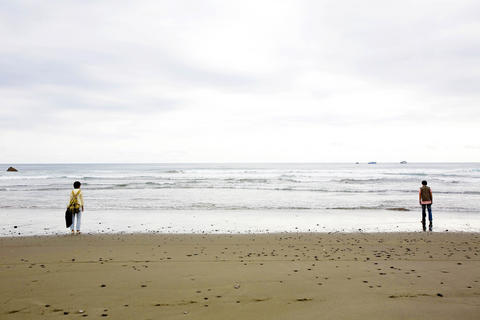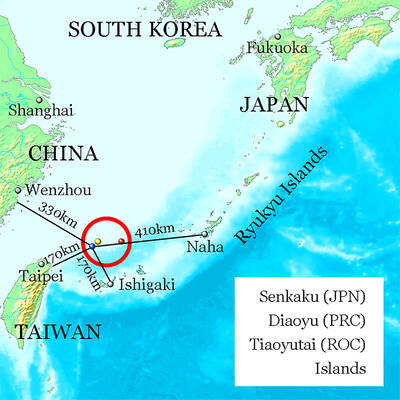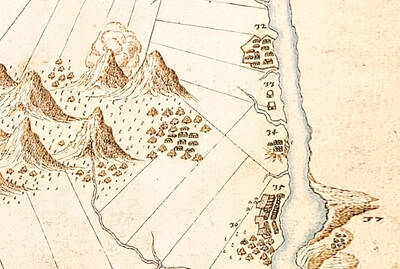Lin Jing-jie's (林靖傑) directorial debut, The Most Distant Course (最遙遠的距離), is one of the most talked-about art-house movies of the year, attracting attention with a high-profile cast led by actress Guey Lun-mei (桂綸鎂) and a story about lone individuals struggling to find their inner selves.
The film follows three emotionally and spiritually crippled Taipei urbanites who are alienated from society.
Psychiatrist A-tsai (Jia Xiao-guo, 賈孝國), who has a talent for piercing the souls of his patients but is unable to cure his own wounds, journeys to Taitung in search of a lost love.

PHOTO: COURTESY OF CHI HSIA FILMS
Young sound recordist Tang (Mo Zi-yi, 莫子儀) is a mess after being dumped by his girlfriend. Hoping to salvage the relationship, Tang circumnavigates Taiwan, recording sounds of the island and sends tape after tape labeled "Sounds of Formosa" to his lover's apartment, now tenanted by Yun (Guey Lun-mei), an office worker suffocated by daily routines and her involvement in a love triangle.
Gradually brought back to life by the simple sounds of the land, Yun sets out on a journey to trace the source of the recordings. The three travelers have different reasons for escaping the capital, but their goal is the same: to find their true selves, which have long been buried and forgotten in the monotony and travails of life.
The script was originally written for director Lin's close friend Chen Ming-tsai (陳明才), an actor who suffered from bipolar disorder and took his own life at Dulan Bay (都蘭灣), Taitung, one year after the screenplay was finished. Nevertheless, hoping to reflect the quest for truth and reality, Lin saw the project through.

PHOTO: COURTESY OF CHI HSIA FILMS
The scene near the end of the film in which the psychiatrist snorkels on the freeway in a diving suit echoes the uncompromising spirit of the late artist who, in the eyes of Lin, refused to become a part of mainstream society and chose to walk a lone path rarely understood by others.
Though the story behind the film sounds depressing, the movie is beautifully shot and interspersed with humor. Mo is decently cast, while Jia delivers a slightly theatrical performance for the role originally written for Chen. Now a regular lead in local productions, Guey exposes her limits as she struggles to express the feelings of the paramour.
Although The Most Distant Course won the best film accolade at the International Critics' Week in Venice and the special jury award at the Taipei Film Festival (台北電影節), the plot is predictable and the story feels a little too familiar. The juxtaposition of gloomy urban landscapes and colorful, soothing scenes of nature is formulaic to the point of being cliche. Despite that, the movie does touch viewers' hearts.

Last week gave us the droll little comedy of People’s Republic of China’s (PRC) consul general in Osaka posting a threat on X in response to Japanese Prime Minister Sanae Takaichi saying to the Diet that a Chinese attack on Taiwan may be an “existential threat” to Japan. That would allow Japanese Self Defence Forces to respond militarily. The PRC representative then said that if a “filthy neck sticks itself in uninvited, we will cut it off without a moment’s hesitation. Are you prepared for that?” This was widely, and probably deliberately, construed as a threat to behead Takaichi, though it

Nov. 17 to Nov. 23 When Kanori Ino surveyed Taipei’s Indigenous settlements in 1896, he found a culture that was fading. Although there was still a “clear line of distinction” between the Ketagalan people and the neighboring Han settlers that had been arriving over the previous 200 years, the former had largely adopted the customs and language of the latter. “Fortunately, some elders still remember their past customs and language. But if we do not hurry and record them now, future researchers will have nothing left but to weep amid the ruins of Indigenous settlements,” he wrote in the Journal of

Even after years in business, weekend tables here can be booked out a month in advance. The price point far exceeds its competitors. Granted, expectations are soaringly high, but something here failed to hit the high notes. There are a few telltale signs that a restaurant relies solely on outstanding food to create the experience, no gimmicks or distractions needed. La Mole is such a restaurant. The atmosphere is food-forward, with an open kitchen center stage. Our tables are simple; no candles, no dim lighting, no ambient music. The menu is brief, and our waiter directs most

If China attacks, will Taiwanese be willing to fight? Analysts of certain types obsess over questions like this, especially military analysts and those with an ax to grind as to whether Taiwan is worth defending, or should be cut loose to appease Beijing. Fellow columnist Michael Turton in “Notes from Central Taiwan: Willing to fight for the homeland” (Nov. 6, page 12) provides a superb analysis of this topic, how it is used and manipulated to political ends and what the underlying data shows. The problem is that most analysis is centered around polling data, which as Turton observes, “many of these